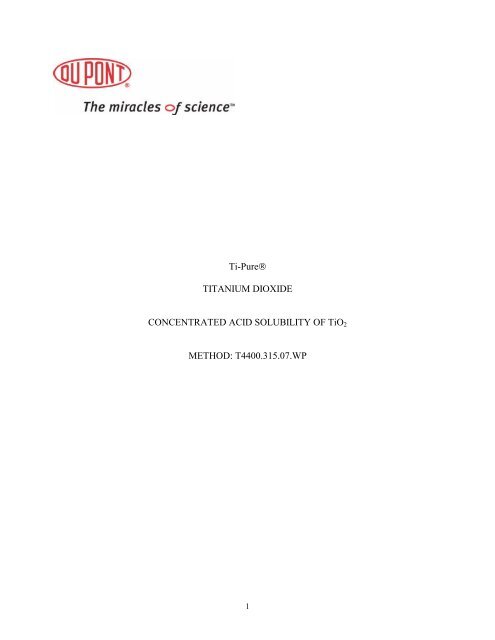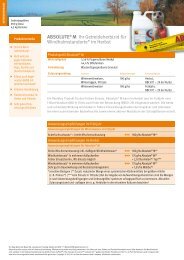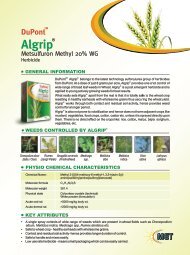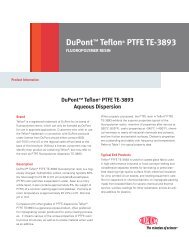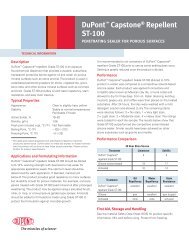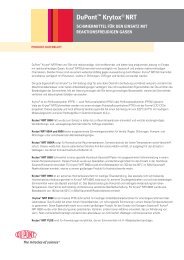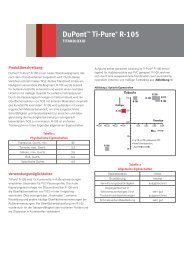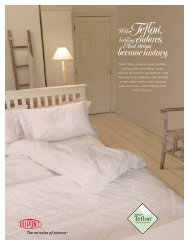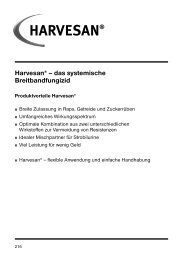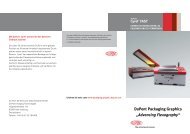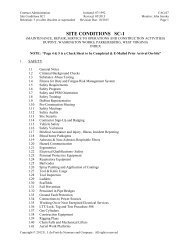Ti-Pure TITANIUM DIOXIDE CONCENTRATED ACID ... - DuPont
Ti-Pure TITANIUM DIOXIDE CONCENTRATED ACID ... - DuPont
Ti-Pure TITANIUM DIOXIDE CONCENTRATED ACID ... - DuPont
Create successful ePaper yourself
Turn your PDF publications into a flip-book with our unique Google optimized e-Paper software.
<strong>Ti</strong>-Pure®<br />
<strong>TITANIUM</strong> <strong>DIOXIDE</strong><br />
<strong>CONCENTRATED</strong> <strong>ACID</strong> SOLUBILITY OF <strong>Ti</strong>O2<br />
METHOD: T4400.315.07.WP<br />
1
I. Principle<br />
<strong>TITANIUM</strong> <strong>DIOXIDE</strong><br />
(<strong>Ti</strong>-Pure®)<br />
Determination of Acid Solubility of <strong>Ti</strong>O2 by Spectrophotometer<br />
(TP-109.2)<br />
<strong>Ti</strong>O2 is a basic oxide and will react with concentrated sulfuric acid to<br />
produce a soluble species. After adding hydrogen peroxide, the soluble<br />
<strong>Ti</strong>O2 can be measured on a spectrophotometer, reading absorbance at<br />
400 mµ. A continuous coating of SiO2, on the <strong>Ti</strong>O2, will prevent the<br />
dissolution of <strong>Ti</strong>O2. The test measures the effectiveness of the SiO2<br />
coating.<br />
II. Applicability<br />
This method applies directly to the determination of acid solubility<br />
of <strong>Ti</strong>O2 coated with insoluble inorganic oxides to determine the<br />
effectiveness of the inorganic coating.<br />
III. Limitations<br />
It has been demonstrated that improved precision is obtainable by<br />
imposing tight controls on the test variables of time and temperature of<br />
acid digestion, keeping the apparatus in a draft-free environment,<br />
keeping Tuttle covers in place and carefully adding the pigment so that<br />
none gets hung up on the wall of the test tube. In addition, absolute<br />
cleanliness of all equipment is necessary. Traces of soap or any<br />
organic will discolor the sulfuric acid and interfere with the subsequent<br />
spectrophotometric analysis.<br />
IV. Sensitivity, Precision and Accuracy<br />
A. Sensitivity<br />
No data are available.<br />
2
B. Precision<br />
1. Single Operator<br />
_<br />
The average analyses (X), standard deviation (s), and 95%<br />
confidence limit (95% CL) established for the single operator<br />
precision of the method were as follows:<br />
_<br />
X s 95%CL<br />
% Acid Solubility 7.040 0.435 ± 0.826<br />
The above data were calculated from 8 replicate analyses of 1<br />
sample of R-960 performed by 1 technician over several days.<br />
2. Multiple Operator<br />
_<br />
The average analysis (X), standard deviation (s), and 95%<br />
confidence limits (95% CL) established for the multiple<br />
operator precision of the method were as follows:<br />
_<br />
X s 95%CL<br />
% Acid Solubility 7.370 0.471 ± 0.895<br />
The above data were calculated from 32 replicate analyses of 1<br />
sample of R-960 performed by 8 technicians, 2 tests on each of<br />
2 days.<br />
C. Accuracy<br />
No data are available but results have been satisfactory based on<br />
experience.<br />
V. Special Apparatus (Equivalent apparatus may be substituted)<br />
1. Magnetic stirrer with hot plate 9" x 9", Model #4817, Cole-Parmer<br />
Instrument Co., Chicago, IL.<br />
3
2. Immersion probe for use with above, Model #4812-1, Cole-Parmer<br />
Instrument Co., Chicago, IL.<br />
3. Thermometer, 1°C - 201°C., #15-043, Fischer Scientific.<br />
Thermometer is calibrated vs. a certified thermometer.<br />
4. Aluminum heating block fabricated locally to contain 13 test tubes<br />
(100 x 25 mm), thermometer and immersion probe. The top and sides<br />
are covered with Kaowool Ceramic cement, a substitute for asbestos<br />
cloth, Babcock & Wilcox, Birmingham AL., or equivalent insulation.<br />
5. Test tubes 100 x 25 mm, #9800-25, Corning Glass Co., Corning, NY, if<br />
available. If not available, obtain 150 x 25 mm (same supplier) and<br />
have them cut down to 100 mm locally.<br />
Quartz tubes have proven equal to the above and are preferred<br />
because of improved durability. Ace Glass Company, Part #30738-000.<br />
6. Tuttle covers, #10-042A, Fisher Scientific.<br />
7. Magnetic Stirring bars, Teflon® coated, 1/2" x 5/16", #4770-2,<br />
Cole-Parmer Instrument Co., Chicago IL.<br />
8. Volumetric flasks, ASTM certified, class A, 25 mL #10-211A, 100 mL<br />
10-211C, Fisher Scientific.<br />
9. Disposable containers with lids (4-oz cap), Containers #11-838-15,<br />
Lids #11-834-2Y, Fisher Scientific.<br />
10. Ice Crusher by Oster #571-06, Oster Division of Sunbeam Corp.,<br />
Milwaukee, WI.<br />
11. Micrometer Dispenser, 10 mL, with flask #7892, Cole-Parmer<br />
Instrument Co., Chicago, IL.<br />
12. Test tube rack, #14-7800, Fisher Scientific Co.<br />
13. Syringe, Plastipak, disposable, 10 mL, #14-823-50, Fisher Scientific<br />
Co.<br />
14. Funnel, polypropylene, #10-320-8D, Fisher Scientific Co.<br />
15. Filter paper, Whatman #5, 18.5 cm.<br />
16. Spectrophotometer, Bausch & Lomb, Model 21.<br />
4
17. Spectrophotometeric cell, 10 mm light path. Calibrated vs.<br />
Certified set, traceable to NIST.<br />
18. Weighing paper, S&S #B-2, 3 x 3 in, #9-898-10A, Fisher Scientific<br />
Co. (or aluminum dishes).<br />
VI. Reagents (Reagent grade except as noted)<br />
1. Sulfuric acid, 66° Be (concentrated), ACS certified.<br />
2. Sulfuric acid, 10% v/v, ACS certified, Tennessee Reagents.<br />
3. Hydrogen Peroxide, 30%, ACS certified.<br />
4. Crushed Ice made from distilled water.<br />
5. Ammonium Sulfate, 99.5% purity, ACS certified, available from local<br />
Fisher Scientific.<br />
VII. Special Safety Considerations<br />
A. Product Hazards<br />
There are no unusual product hazards. However, titanium dioxide is<br />
regulated as an air contaminant and care should be exercised to<br />
minimize product dusting. Wipe up all spills with a damp paper<br />
towel. Refer to MSDS #2816CR for more information on <strong>Ti</strong>tanium<br />
Dioxide.<br />
B. Procedure Hazards<br />
1. Hot Plate - "High Heat"- use tongs when handling hot glassware.<br />
Always use hot plate under hood to avoid acid fumes.<br />
2. Glassware - inspect for chips and cracks before using. Careful<br />
examination of the bottoms of the test tubes is very important.<br />
Discard if scratched or chipped.<br />
3. Ice Crusher - Keep fingers clear of blades.<br />
4. Sulfuric Acid - Can cause severe burns, especially when hot.<br />
Extreme care must be used at all times. A full face shield and<br />
Neoprene gloves must be worn.<br />
5
NOTE: Sulfuric Acid is extremely irritating in vapor or liquid<br />
form, especially when hot. Use only in a<br />
well-ventilated area. Neoprene gloves and face shield<br />
must be worn when handling. "ALWAYS POUR <strong>ACID</strong> INTO<br />
WATER—NOT WATER INTO <strong>ACID</strong> EXCEPT IN CERTAIN<br />
CAREFULLY CONTROLLED CASES WHEN IT IS<br />
NECESSARY TO THE TEST, AND THEN FOLLOW THE<br />
PROCEDURE WITH EXTREME CARE.”<br />
VIII. Procedure<br />
5. 30% Hydrogen Peroxide - Very strong oxidizing agent. Do not<br />
mix with organic materials or peroxidizables. Use full face<br />
shield and rubber gloves when handling.<br />
6. Refer to Material Safety Data Sheets for any chemical used in<br />
this test with which you are not familiar.<br />
A. Operating Conditions<br />
Refer to the manufacturer's operating instructions for the<br />
spectrophotometer.<br />
B. Calibration<br />
Preparation of Spectrophotometric Curve<br />
1. Weigh exactly 1.0118 g of the (DUPONT 98.83% <strong>Ti</strong>O2 ANALYTICAL<br />
STANDARD <strong>Ti</strong>-Pure®) and transfer to a 300-mL Erlenmeyer flask.<br />
2. Add 15 ± 0.1 g ammonium sulfate and 20 ± 0.1 mL of concentrated<br />
sulfuric acid.<br />
3. Place Tuttle cover in mouth of the flask, mix thoroughly by<br />
swirling, then heat gently to complete solution.<br />
4. Cool to room temperature, then CAREFULLY DILUTE SOLUTION<br />
WITH APPROXIMATELY 80 mL OF DISTILLED WATER and<br />
transfer to 1-L, CLASS A, volumetric flask. (This step is in violation<br />
of the generally accepted rule of not adding water to acid but is<br />
necessary to the test and with care can be done safely.) Rinse<br />
flask with distilled water, adding washings to volumetric flask.<br />
Dilute further with distilled water to about 800 mL. Carefully<br />
add 80 mL of concentrated sulfuric acid, mix and cool to room<br />
temperature. Dilute to 1000 mL mark with distilled water.<br />
6
5. This solution contains 0.001 g <strong>Ti</strong>O2/mL. Let stand one week<br />
before using.<br />
6. Transfer 2 ± 0.01 mL of the standard <strong>Ti</strong>O2 solution, using a<br />
class A pipette, to a 100-mL, class A, volumetric flask.<br />
7. Add 10 ± 0.1 mL of 30% hydrogen peroxide with a disposable 10 mL<br />
plastic syringe.<br />
8. Dilute to volume, using 10% sulfuric acid and mix.<br />
9. Repeat Steps 6, 7 and 8 using 4, 6 and 8 mL of standard solution.<br />
10. To prepare a reference solution, add 10 ± 0.1 mL of 30% hydrogen<br />
peroxide to a 100 mL, Class A, volumetric flask with a 10 mL<br />
plastic syringe, and dilute to 100 mL mark with with 10%<br />
sulfuric acid.<br />
11. Allow to stand at least 1 hour before reading absorbance.<br />
12. Values of the four samples prepared above are 20, 40, 60 and 80<br />
mg <strong>Ti</strong>O2/L.<br />
13. To convert mg/L <strong>Ti</strong>O2 to % soluble <strong>Ti</strong>O2, divide mg/L <strong>Ti</strong>O2 by 8.<br />
* See Appendix 3 for information on where the factor 8 comes from.<br />
14. Read absorbance of the 4 standard solutions against the<br />
reference solution at 400 mµ using 10-mm cell. Record results<br />
to two decimal places.<br />
15. Construct a spectrophotometric curve on graph paper of<br />
absorbance vs. % soluble <strong>Ti</strong>O2. Example of such a curve is shown<br />
in Appendix 1.<br />
C. Sampling<br />
1. Samples are normally supplied by manufacturing.<br />
D. Sample Analysis<br />
1. On the day of testing, working in the hood, place aluminum<br />
heating block on magnetic stirrer/hot plate. (A shield should<br />
be placed around the hot plate and heating block to prevent<br />
drafts from affecting the temperature of the block during the<br />
7
test). Insert remote temperature sensor and thermometer into the<br />
appropriate thermal wells in the heating block. Adjust<br />
temperature to 175 ± 2°C. The top and sides of the aluminum<br />
block are covered with Kaowool Ceramic Cement (or equivalent<br />
insulation) to limit the heat loss.<br />
2. Fill the required number of disposable 4-oz containers<br />
approximately 1/4 full with crushed ice made from distilled<br />
water. Fasten lids and store in the freezer, until ready for<br />
use.<br />
3. Absolute cleanliness of all equipment is necessary. Traces of<br />
soap or any organic material will discolor the sulfuric acid<br />
and interfere with the subsequent colorimetric analysis.<br />
4. Place a magnetic stirring bar into each test tube.<br />
5. Add 10 ± 0.01 mL 66° (concentrated) sulfuric acid to the test<br />
tubes using micrometer dispenser.<br />
6. Place each test tube in the appropriate position in the heating<br />
block and cap each tube with a Tuttle cover. Adjust magnetic<br />
stirrer to position 7. Before inserting test tube into block<br />
make sure the outside of the tube is dry. Moisture on the<br />
outside of the tube, inserted into the hot block, could form<br />
steam, causing the tube and contents to blow out of the block<br />
and cause an injury.<br />
7. Weigh 0.2000 ± 0.0005 g of each sample and standard on weighing<br />
papers or aluminum dishes, and set aside.<br />
8. After approximately 15 - 30 minutes the temperature of the block<br />
should have again reached 175 ± 2°C. Add the samples and<br />
standard to the sulfuric acid at 15 second intervals, noting the<br />
time when the first sample was added. Add pigment so that a<br />
minimum amount adheres to the side of the tube. Replace Tuttle<br />
covers.<br />
9. Digest samples for 60 ± 1 minute.<br />
10. About three minutes before the end of the digestion period,<br />
arrange numbered plastic containers of crushed ice near the work<br />
area in the hood. If timing is correct, there will be no ice<br />
melted before sample is added.<br />
8
11. After one hour digestion, remove Tuttle cover, grasp test tube<br />
with tongs and quench by rapidly pouring contents into container<br />
of crushed ice. After digestion mixture is poured, put test tube into<br />
container, mouth down. Full face shield and apron must be worn.<br />
The use of a safety shield is recommended. The tubes must be<br />
quenched at 15 second intervals (as in loading) to give all tubes<br />
the same one hour digestion period.<br />
12. Wash residue in test tubes using distilled water and collect<br />
washings in container from which test tube was removed.<br />
13. Transfer contents of plastic container into a 100-mL, Class A,<br />
volumetric flask. Wash container with distilled water,<br />
collecting washings in the volumetric flask.<br />
14. Dilute to the 100 mL mark on the flask with distilled water,<br />
stopper and mix thoroughly.<br />
15. Filter sample by gravity using two, #5, 18.5 cm Whatman filter<br />
papers. Collect the filtrate in the original 4-oz. container<br />
after washing and drying. The filtrate must be clear and free<br />
of turbidity. Refilter if the slightest sign of turbidity is<br />
present. Yellow to black color indicates sign of organics.<br />
16. Using a disposable 10 mL plastic syringe, add 10 ± 0.1 mL of<br />
filtrate to a 25-mL, Class A, volumetric flask.<br />
17. Add 2 ± 0.1 mL 30% hydrogen peroxide using a 10 mL plastic<br />
syringe.<br />
18. Dilute to volume with 10% sulfuric acid. Stopper and mix well.<br />
19. Prepare a blank by taking 2 ± 0.1 mL 30% hydrogen peroxide and<br />
diluting to 25 mL mark with 10% sulfuric acid in a Class A<br />
volumetric flask.<br />
20. Turn on spectrophotometer and allow samples to stand at least 1<br />
hour before reading.<br />
21. Read absorbance of standard and samples using a 10 mm cell. Set<br />
spectrophotometer at 400 mµ. Cell must be thoroughly cleaned<br />
and checked before using. Record the result to two decimal<br />
places.<br />
9
22. If the final color is so intense that it cannot be read on the<br />
spectrophotometer, use a smaller aliquot (5 mL, 2 mL or 1 mL);<br />
starting with Step 15 above. See Step 4 in Calculation for<br />
compensating calculation.<br />
E. Calculations<br />
The absorbance reading is entered into the CQMS Acid Sol.<br />
Program in the computer and the computer calculates and<br />
reports the results.<br />
NOTE: If the computer is not available, the following<br />
calculation should be used:<br />
1. Convert absorbance reading to % soluble <strong>Ti</strong>O2 using chart<br />
in Appendix 1. (The chart was prepared in Section VIII-B<br />
above.)<br />
2. Correct measured values of % soluble <strong>Ti</strong>O2 by multiplying the<br />
measured value by a correction factor. This factor is obtained<br />
by dividing the standard value of % solubility by the measured<br />
value of % solubility of that standard. Report result to one<br />
decimal place.<br />
Calculation of correction factor:<br />
Correction Factor =<br />
Actual value of % solubility of standard<br />
Measured value of % solubility of standard<br />
Calculation of corrected value of % solubility of a sample:<br />
Corrected value = Correction factor X Measured value<br />
3. Example using 2.98% solubility standard<br />
Standard Sample<br />
Actual % sol. <strong>Ti</strong>O2 2.98 ----<br />
Absorbance Reading 0.20 0.28<br />
mg/L <strong>Ti</strong>O2 20.8 28.6<br />
Measured % sol. <strong>Ti</strong>O2 2.600 3.575<br />
10
Correction Factor = 2.98/2.600 = 1.1462<br />
Corrected % Soluble <strong>Ti</strong>O2 = 1.1462 X 3.575 = 4.1%<br />
4. If smaller aliquots were used because of intense color<br />
development, the final % soluble <strong>Ti</strong>O2 is multiplied by a factor<br />
selected from below according to the volume of sample.<br />
IX. Quality Control<br />
Vol. of<br />
Sample Factor<br />
5 mL X2<br />
2 mL X5<br />
1 mL X10<br />
Use appropriate Statistical Process Control procedures as established<br />
in the site Control Lab for this test. (Absorbance of standard is<br />
recommended).<br />
X. Comments<br />
Acid solubility has been used as a method of determining the extent<br />
that inorganic additives have protected the titanium dioxide from<br />
the vehicle.<br />
XI. References<br />
None<br />
XII. Appendix<br />
1. An Example of an Acid Solubility Chart (absorbance vs. %<br />
solubility).<br />
2. Aluminum Block.<br />
The information set forth herein is furnished free of charge and is based<br />
on technical data that <strong>DuPont</strong> believes to be reliable. It is intended for<br />
use by persons having technical skill and at their own discretion and risk.<br />
Since conditions of use are outside our control, we make no warranties,<br />
express or implied, and assume no liability in connection with any use of<br />
this information. Nothing herein is to be taken as a license to operate<br />
under or a recommendation to infringe any patents.<br />
11
APPENDIX 1<br />
PERCENT SOLUBLE <strong>TITANIUM</strong> <strong>DIOXIDE</strong> AS A FUNCTION OF OPTICAL DENSITY AT<br />
400 µm<br />
(Typical Curve)<br />
"Contact Methods Manager for hard copy"<br />
APPENDIX 2<br />
DESIGN OF ALUMINUM BLOCK<br />
"Contact Methods Manager for hard copy"<br />
12


